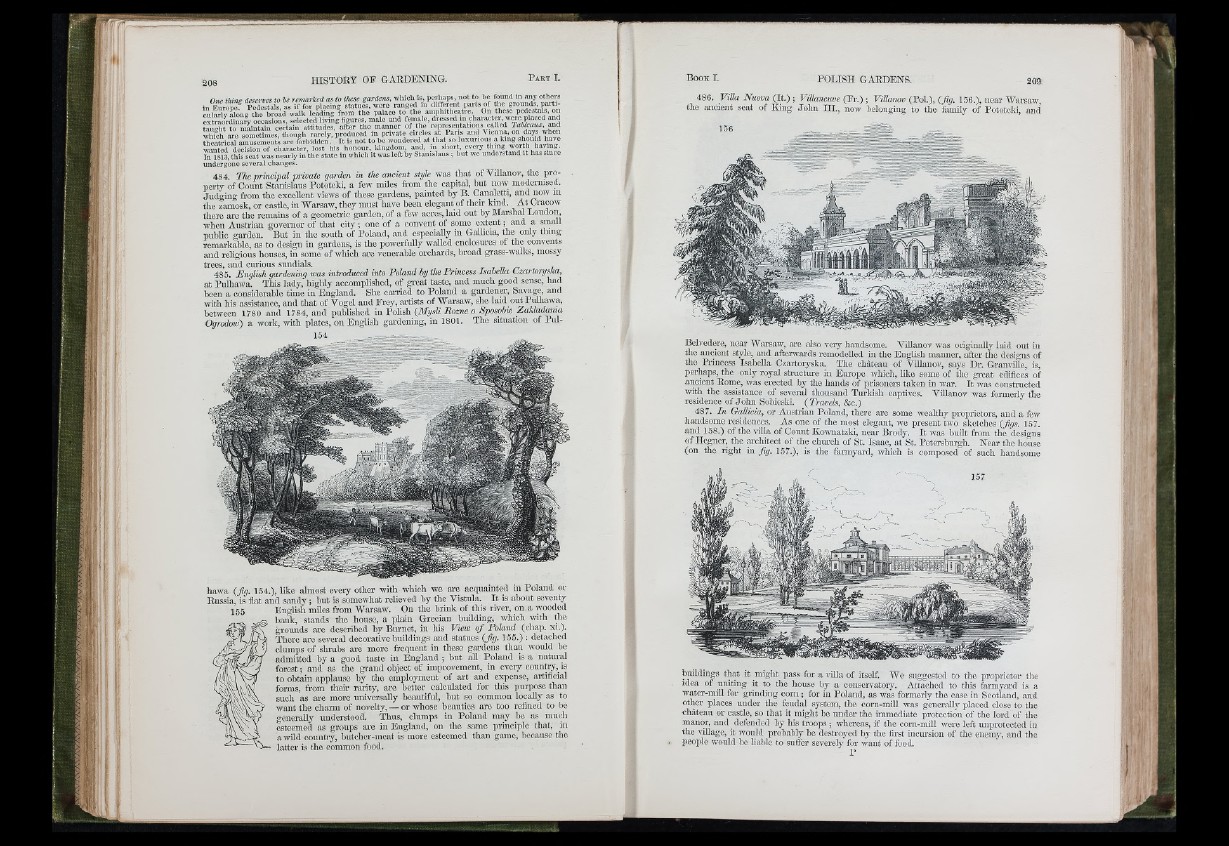
n m Ihine deserves to he remarked as to these, gardens, which Is, perhaps, not to bo found In any others
v n x tning w ye ____ cf-.ci,oet «/or.» mDypil in different parts of in^Riirone“ Pedestals as if for placing statues, were rang-— .................... t.h e grounds, par^t i- i
c L a riv /lo n g th e bra walk le/ding from th e palace to the amphitheatre. On these pedpta ls,
/ x t ? a o 1 - S y occasions, selected l i v i ^ figures, male and female, dressed m character, were placed and
taught to maintain certain attitudes, after the manner of th e representations called Tableaux, and
w l S a r e rarely, produced in private circles at Paris and Vienna, on days when
theatrical amusements are forbidden. It is not to be wondered at th a t so luxurious a king should have
wanted decision of character, lost his honour, kingdom, and, m short, every thing worth having.
In 1813, this seat was nearly in th e state in which it was leff by Stanislaus ; but we understand it has since
undergone several changes.
484. The principal private garden in the ancient style was that of Villanov, the property
of Count Stanislaus Pototcld, a few miles from the capital, hut now modernised.
Judging from tho excellent views of these gardens, painted by 15. Canalctti, and now m
the zamosk, or castle, in Warsaw, they must have been elegant of their kind. A t Cracow
there are the remains of a geometric garden, of a few acres, laid out by Marslial Loudon,
when Austrian governor of that city ; one of a convent of some ex ten t; and a small
public garden. But in the south of Poland, and especially in Gallicia, the only thing
remai'kable, as to design in gardens, is the powerfully walled enclosm'cs of the convents
and religious houses, in some of wliich ai'C venerable orchards, broad grass-walks, mossy
trees, and cni-ious sundials. r » ^ i
485. English gardening was introduced into Poland by the Princess Isabella Czartoryska,
at Pulhawa. This lady, highly accomplished, of great taste, and much good sense, had
been a considerable time in England. She carried to Poland a gardener, Savage, and
m th his assistance, and tliat of Vogel and Frey, artists of Warsaw, she laid out Pimiawa,
between 1780 and 1784, and published in Polish (Mysli Eozne o Sposobie Zakladania
Ogrodow) a work, with plates, on English gardening, in 1801. The situation of lu l -
154
hawa (fig. 154.), like almost every other with which we are acquainted in Poland or
Russia, is flat and s an d y ; but is somewhat relieved hy the Vistula. I t is about seventy
155 English miles from Warsaw. On the brink of this river, on a wooded
bank, stands the house, a plain Grecian building, which with tlie
grounds are described by Burnet, in his View o f Poland (chap. xi.).
There arc several decorative buildings and statues (fig. 155.) : detached
clumps of shrabs are more frequent in these gardens than would he
admitted by a good taste in England ; but all Poland is a natural
forest; and as the grand object of improvement, in every country,is
to obtain applause by the employment of art and expense, artificial
forms, from their rarity, are better calcidated for this pui-posc than
such as are more universally bcaiitiful, but so common locally as to
want the charm of novelty,— or whose beauties are too refined to be
generally understood. Thus, clumps in Poland may he as much
esteemed as gvoups are in England, on the same principle that, in
a wild country, butchcr-meat is more esteemed than game, because tiic
■Vw latter is the common food.
486. Fii7/a Nuova (It.) ; Villancuve (F r.) ; Villanov (Pol.), (fig. 156.), near Warsaw
the ancient seat of King Jo h n III., now belonging to tho famfiy of Pototcki, and
Belvedere, near Wai-saw, are also very handsome. Villanov was originally laid out in
the ancient style, and aftenvards remodelled in the English manner, after tlie designs of
the Princess Isaliella Czartoryska, Tlie château of Villanov, says Dr. Granville, is,
perhaps, the only royal structure in Europe which, like some of the gi-eat édifices of
ancient Romp, was erected by the hands of prisoners taken in war. I t was consti-ucted
with the assistance of several thousand Turkish captives. Villanov was formerly the
residence of John Sobieski. (Travels, &c.)
487. In GaUicia, or Austrian Poland, there are some wealthy proprietors, and a few
handsome residences. As one of tlie most elegant, we present two sketches (figs. 157.
and 158.) of the villa of Count Kownatzki, near Brody. I t was built from the designs
of Hcgner, the architect of tlie church of St. Isaac, at St. Petersburgh. Near the house
(on the right in fig. 157.), is the farmyai-d, which is composed of such handsome
buildings that it might pass for a villa of itself. We suggested to the proprietor the
idea of uniting it to the liouse by a conseiwatory. Attached to this farmyard is a
water-mill for grinding corn ; for in Poland, as was formerly the case in Scotland, and
other places under the feudal system, the corn-mill was generally placed close to the
château or castle, so that it might be under the immediate protection of the lord of the
manor, and defended by his troops ; whereas, if the corn-mill were left unprotected in
the village, it would probably be dcsti'oycd by the first incursion of the enemy, and the
people would be liable to suffer severely for want of food.
P